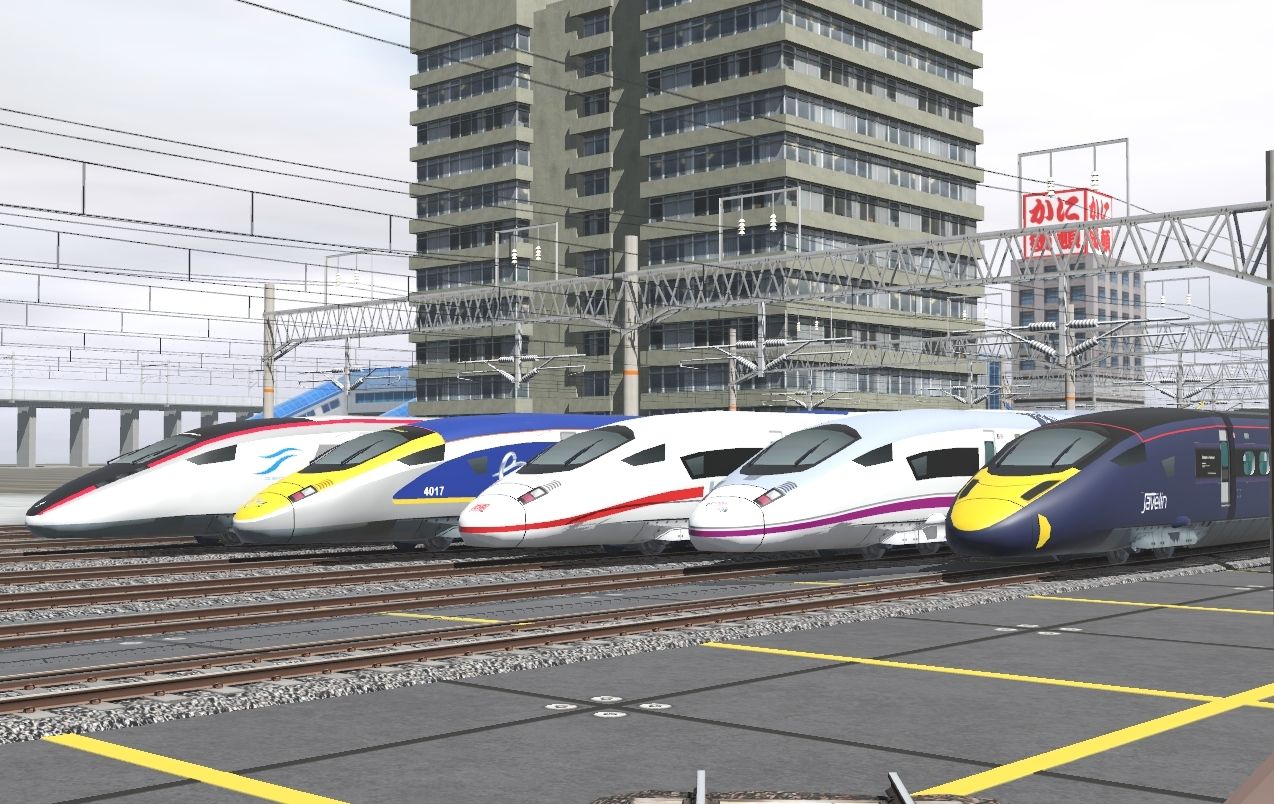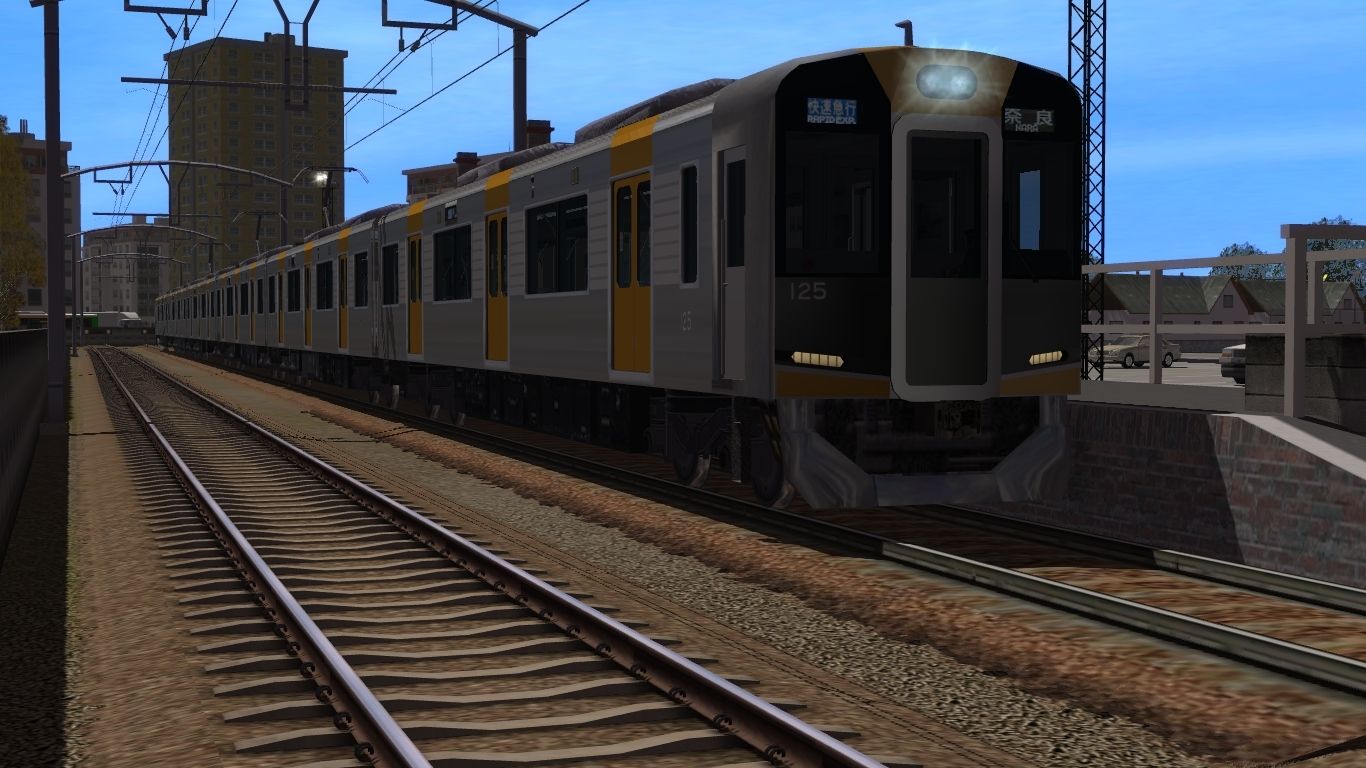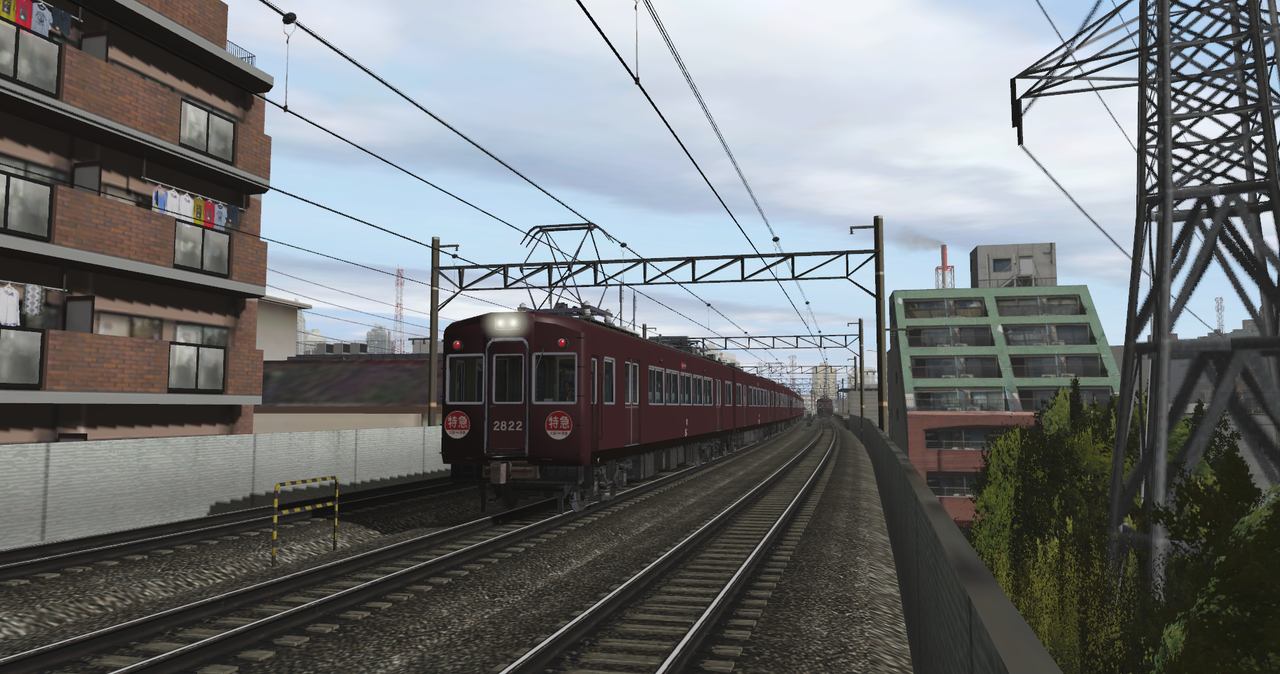So im redoing Hashin's C62, and I need some Number suggestions as well as Headboard suggetions?
Just a quick question: what do you mean by "redoing"?
"redoing" as my "refurbishments" of Keimei's old trains (new textures, new custom dependencies and scripts...) or actually "redoing" from scratch?
Speaking of "refurbishments" - here's my lastest completed pack - Hankyu Railway's "standard" commuter trains!
A brief note: originally, this was to be a pack only about the 2300 Series, but then i found out that i could change the front numbers as well, and
oh boy...
I ended up with seven different trains, spanning about 20 years: the 2000, 2100, 2300, 3000, 3100, 3300 and 5000 Serieses. I did plan to make the 5100 and 5200 Series as well, but i decided to "limit" myself only to trains that had both no air conditioning and the top-mounted headlights only, as the former two entered service with air-conditioning already fitted. Nonetheless, i still ended up with quite a lot of models, and this is part of the reason why this otherwise easy "refurbishment" pack took so long to make.
Also, each pack contains consists with both with and without Hankyu's iconic "express" headboard.
Part 1: "2X00 Series" (2000, 2100 and 2300 Serieses) - download [here] (will soon be avaible on my website as well)
By the late 1950s Hankyu Railway was still relying on a majority of indaequate pre-war and substandard wartime and immediately-post-war-built stock, along a minority of more "modern" stock built in the mid-1950s that however had been built with old and nearly obsolete design concepts in mind, such as single-leaf passenger doors, and some (such as the 1200 Series) even used bogeys and traction equipment salvaged from withdrawn 600 and 920 Series trains dating from the late 1920s and early 1930s!
With ridership sharply increasing, a new train was badly needed, and as the rolling stock situation was quite dire on the entirety of Hankyu Railway's lines, a "standard" new commuter train design for the entirety of the network seemed the most appropiate choice.
Jointly designed, the new 2000 and 2300 Serieses entered service in 1960, on the Kobe and Kyoto Lines respectively, with the 2100 Series for the Takarazuka Line following suit in 1961.
The "2X00" series trains were ground-breaking in many ways, being Hankyu railway's first commuter rolling stock with double-leaf passenger doors, smooth, all-welded, lightweight steel bodyshells, wich meant a considerable "weight-saving" wich meant that an "all-motor-car" configuration was no longer needed to keep with the tight schedules, and in turn, it meant less wear-and-tear on the tracks and infrastructure, and most importantly, a considerable energy saving.
Depsite the appearances, the bodyshell design had actually simplied compared the predecessors of the 2X00 series, wich again, meant another considerable saving of time and money when manufacturing a large amount of trains.
Besides ease and "inexpensiveness" of manufacture, passenger comfort was also one of Hankyu railway's major concerns. The new trains were fitted with all-longitudinal seating with velvet-like olive-green upholstery and mahogany-like interior paneling. Passenger windows, retained inside an alluminium frame, were greatly enlarged and, as the trains weren't fitted yet with air conditioning, could be fully opened to let fresh air in. Finally, instead of the more usual curtains, these trains used shutter-like window covers that the passenger could rise (as they moved from "bottom-up" rather than the more usual "top-down").
The bogeys were also unusual, as Hankyu choose to import French-made Alstom and West-German-made Minden-Deutz bogeys for the new trains, with the latter proving superior to the former and being later built under license by Sumitomo Heavy Industries for the rest of the fleet. These bogeys, types FS-333 and FS-344, were equipped with a pneumatic suspension system, rather than the usual hard spring-type suspension, wich again increased passenger confort, and made Hankyu one of the first railways in Japan to adopt such suspension system.
But the most advanced fetaures of the 2X00 Serieses were neither in the bodyshell nor in the interior, but were rather in the traction control equipment, as the 2X00 Series were Hankyu railway's first trains equipped with cardan-drive motors, regenerative and electromagnetic braking, but most importantly, they were fitted with an unique transistor-controlled camshaft resistor traction control system with automatic switching: in other words, if earlier trains only had 5 "fixed" notches (0, Shunt, Series, Series-Parallel, Parallel), with this system, the controller "positions" in the cab remained five, but the speed notches became 227, changing automatically by a servomotor. This resulted in an extremely smooth accelleration performance, something that would be equaled only more than a decade later, with the introduction of the chopper control system.
Lastly, this innovative control system also fetaured an unique "fixed-speed" setting, a sort of "cruise control" where the train (upon imput from the driver) would maintain a fixed speed of 50, 65, 80, 90, 100 or 105Km/h, a very useful fetaure when running express and rapid services.
Combining all these incredibly modern fetaures (in 1960!), the 2X00 Series were nicknamed the "auto-car" or "artificial-brain-train" by railwaymen and railfans alike.
While mostly identical, the 2000, 2100 and 2300 Series were designed with several minute differences between them, to better adapt to their respective lines:
The 2000 Series for the Kobe Line can be considered the "basic" version, with 1500v DC-only equipment, a 110Km/h maximium speed and 150Kw power with a 84:16 (5,25) gear ratio for "flat" lines. The 2300 Series for the Kyoto Line, introduced in the same year, is nearly identical to the 2000 Series, except that these were initially fitted with dual-voltage capability as they had to briefly run under the Takarazuka Line's catenary, wich still used 600v DC, between Juso and Umeda stations. Dual-voltage equipment was later removed from the 2300 Series when the Takarazuka line's catenary voltage was increased from 600v to 1500v DC in 1969.
The 2100 Series for the Takarazuka Line had the most differences from the equivalent 2000 and 2300 Serieses introduced a year earlier. Firstly, as mentioned earlier, the Takarazuka Line's catenary voltage was still 600v DC (a renmant from the era when the line operated as a tramway), so the 2100 Series was fitted with 600v DC-only equipment, altough predisposed for a possible conversion to 1500v DC (wich eventually happened in 1969). Furhtemore, compared to the mostly flat and straight Kyoto and Kobe Lines, the Takarazuka Line had several steep slopes and tight curves, so the gearing of the 2100 Series was changed to a 6.07 Ratio, less adapt to high speeds but better for ascending slopes. The "fixed speed" settings were changed as well: instead of the "usual" 50, 65, 80, 90, 100 or 105Km/h of the 2000 and 2300 Serieses, the 2100 Series had 45, 60, 70 and 80Km/h speed settings.
Besides these three serieses, there was a fourth one, the "2021 Series" (wich is generally considered to be part of the 2000 Series). These trains, intended to supplement the 2100 Series on Takakrazuka Line services, were built to the Kobe Line 2000 Series's standards but were also fitted with dual-voltage equipment. When the Takarazuka Line's voltage was increased to 1500v DC, the 2021 Series's dual voltage equipment was removed and the whole series was reclassified "2071 Series".
All the three "2X00 Serieses" were built by Naniwa Koki (later Alna Koki, a manufacturer owned by Hankyu Railway itself) between 1960 and 1967. In total, 42 cars of the 2000 Series, 30 of the 2100 Series, 42 of the 2021 Series and 78 cars of the 2300 Series were manufactured, for a grand total of 192 "2X00" cars built. These were all originally formed in 2-car sets, being coupled togheter in service to form 4-car sets.
Later, between 1962 and 1963, 3-car sets were introduced as well, with trains now being formed as 5, 6 or 7-car sets. Finally, when deliveries of the 2X00 Serieses ended, most of the trains in service on the "Main Lines" were formed in 6, 7 or 8-car sets, while the branchlines operated with 3 and 4-car sets (with most "unused" intermediate cab cars being converted to straight trailer cars with the removal of the cab and the control equipment).
Starting from 1977, air conditioning was retrofitted on the 2000 Series, with the 2300 Series following suit a year later.
By the late 1980s, the 2000 Series had severely deteriorated and as such a replacement was needed, coming under the form of the 8000 Series, wich had entered in service in 1988. "Mainline" 2000 Series services ended in the same year, with most of the fleet remaining on branch-line services until 1992, when they were replaced as well. Some surplus 2000 Series cars were however sandwiched into other serieses formations, managing to stay in service until 2014.
Soon after, the 2300 Series had been almost completely replaced as well by the brand-new 1300 Series, with the last of these iconic maroon-colored trains making it's final run on the Kyoto Line on the 22nd March 2015.








